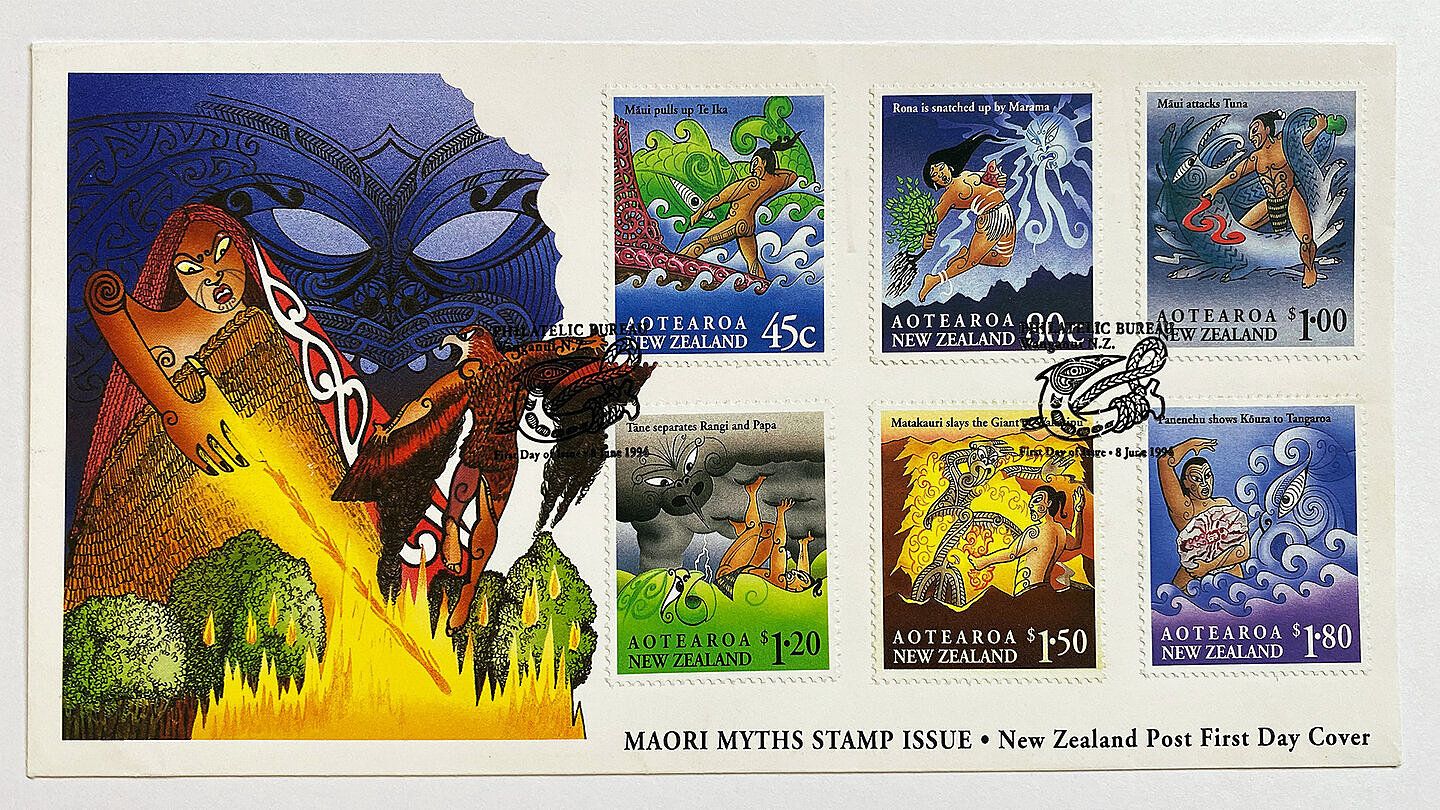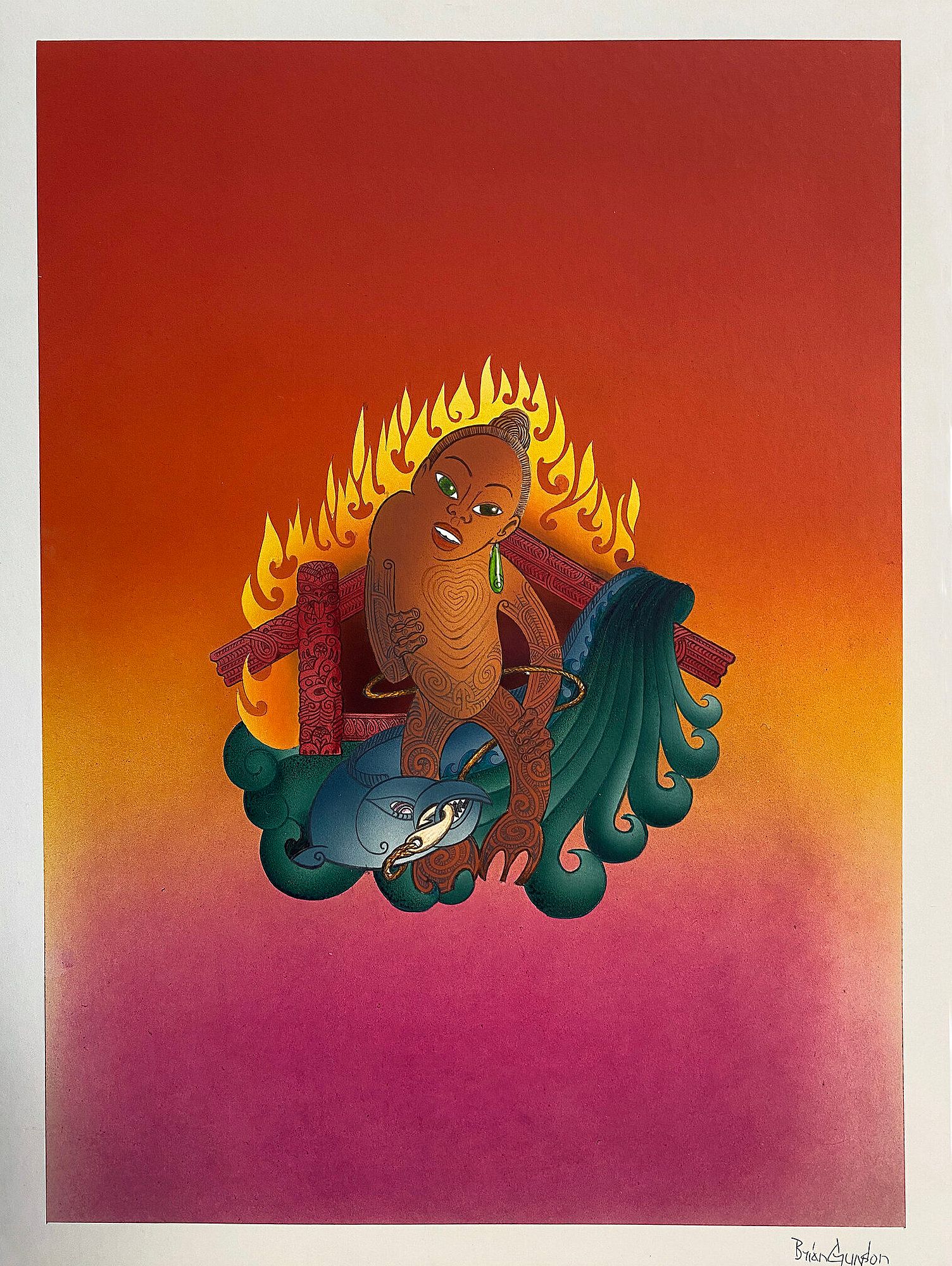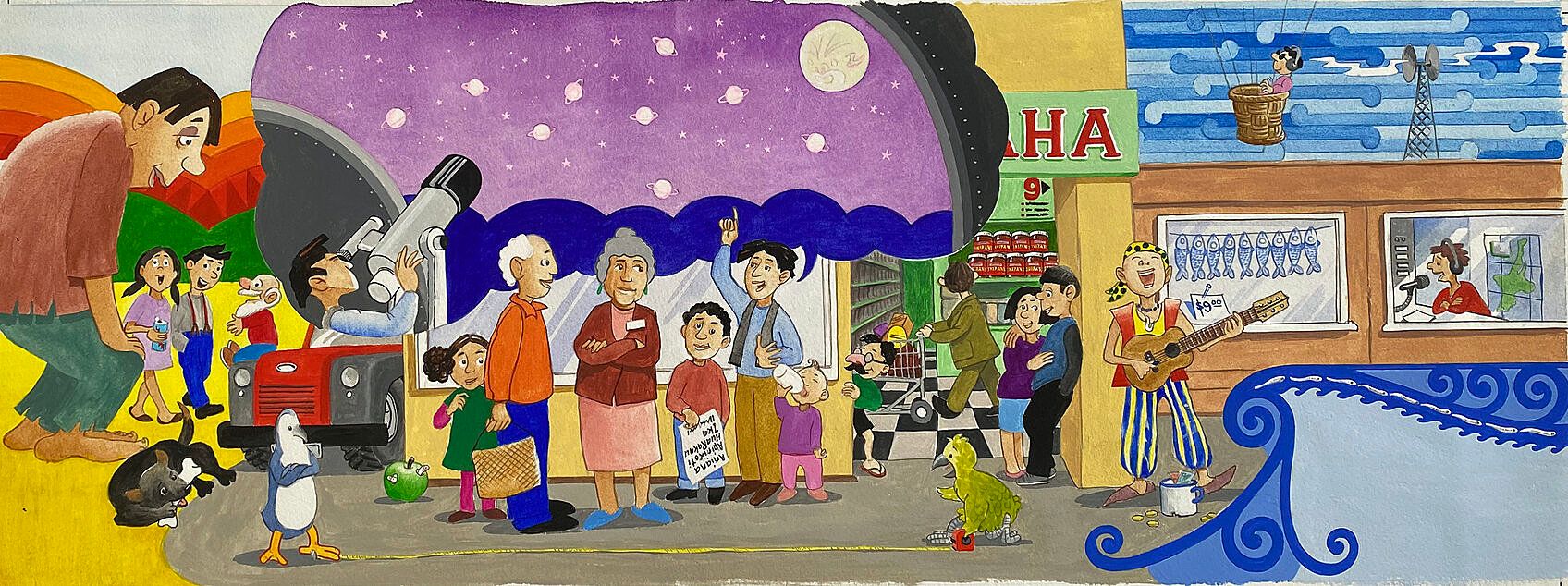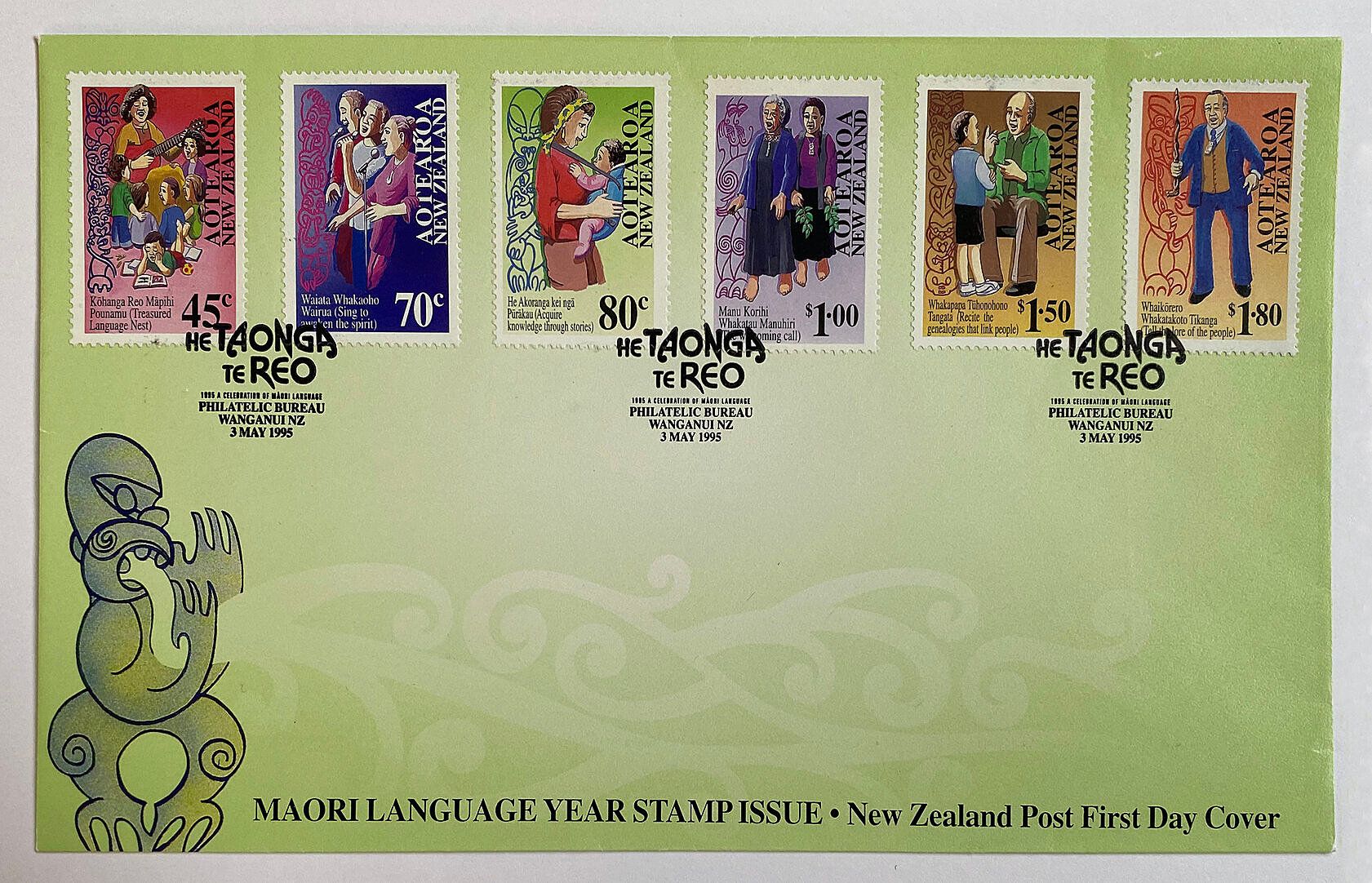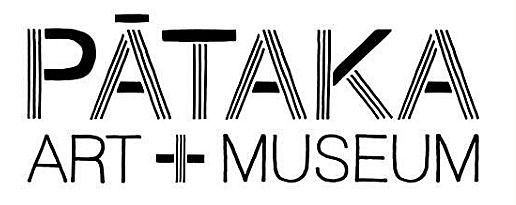Mana of the Man: Brian Gunson
Many seeds were planted at Hongoeka Marae by illustrator and designer Brian Gunson, whose memory and works were honoured in the exhibition Brian at Pātaka Art + Museum. Arihia Latham revisits his legacy.
Aroha ki te tangata, ahakoa ko wai, ahakoa nō hea
As Te Rā dips behind Mana Island, the gold afternoon light amplifies the feeling of being held. Nestled by the hills of Hongoeka is a marae where tamariki go one day a week to make art. This creative and nurturing community didn’t just spring up out of nowhere. It has a history. An intentional creative space was carefully tended, like seeds in the māra of the future. In the curving bay looking back to Porirua, Pātaka Art + Museum has just held the exhibition Brian in honour of a man who sowed many of these seeds and held whānau and community in his creative heart. Brian Gunson was a kaumātua from Hongoeka, and his drawings and imagination carved out spaces for others to come and fill in once he left for the stars. His elder sister, author Patricia Grace, says they cut their creative teeth together, building huge imaginary worlds.
“At home there were just the two of us; he was younger than me by four years. We made up our own pretending games, taking on a different persona, whether these be comic characters such as Ernie Entwhistle, Popeye or Deed-a-Day Danny. From movies (the pictures), we could be inspired to play out the deeds of Tarzan, pirates and highway robbers. We shared a bedroom until I was about 11. We liked the idea of being orphans, so at night after lights out, one of our favourite games was to pretend to be walking the roads, sleeping rough and foraging for food. Brian was a great childhood companion. I was always amazed by his talent for drawing, and he was also a good musician. As a brother, he was always cheerful, imaginative and generous.”
This sense of imagination and the ability to breathe life into characters continued into Gunson’s life as an artist and designer. The sibling relationship working as author and illustrator unfolded as their careers did. The cover artwork that Gunson created for Grace’s novel Potiki is vibrant and fiery, and the eye is subtly drawn to the tā moko etched like rings of a tree at the central figure's heart. It is this heart that is palpable in Gunson’s work.
The cover artwork that Gunson created for Grace’s novel Potiki is vibrant and fiery
Brian Gunson, Potiki. Written by Patricia Grace
A bright-lilac wall faced us at the entrance to Brian at Pātaka, holding illustrations from Joe Pohatu’s Wakapū by Huia Publishers, one of the many books Gunson created rich visual stories for. Others, such as those he created for Ka Noho Mātou i te Taha Moana and Kei Hea Taku Pōtae? written by Waiariki Grace, feel as though they draw the reader into the story – the ideal role of an illustrator. Having read these to my daughter, I know that the power of the illustration is to access and portray a childlike viewpoint that tells the story as children imagine it. This requires the artist to have a strong sense of their inner child, and Gunson seems to have kept his youthful vision thriving.
Brian, 2022, Pātaka Art + Museum, installation view
I could’ve stood there for hours. The detail and careful thought put into each illustration is mind-blowing. And hilarious. Gunson’s humour is evident at every turn. In Wakapū, we watch a kororā (little blue penguin) and a kākāpō steal the show in every picture as they quarrel, sing, play tag and hug. These pictures make you smile. Walking through the exhibition, I continued to get this sense of his playful and engaging nature described by his niece Kohai Grace.
“Us kids used to call him ‘Uncle Rembrandt'. We always thought he was cool. He had old-school cars, was in a band, played guitar and saxophone, sang, and was good at art. He always had time for us, liked to talk, and showed a real interest in what we were doing, whether as kids or as adults. We always looked forward to the Christmas cards he made, drew, or painted for us – every year, we received something different.”
The survey of Gunson’s work showed his diversity. Pencil sketches demonstrated his raw skill at capturing expression and feeling. Framed illustrations of Maraea and the Albatrosses, written by Patricia Grace and illustrated by Gunson, showed beautiful depictions, softer and more spacious, of toroa swooping and diving.
Brian Gunson, Wakapū, 2001. Written by Joe Pohatu
The exhibition included some of his most recent paintings in acrylic. Māui slowed the sun and the three panels of Ka Mate, Ka Ora also spoke to the works sitting in the exhibition Whiti te rā in the main Pātaka gallery, depicting Ngāti Toa’s migration and the story of Te Rauparaha. These examples reveal Gunson’s incredible ability to tell stories through his art. The colour blocking and composition of these paintings are strong, and I would love to see more of this style from him. It felt like he got to paint these pieces with time and experience behind him, and perhaps more for himself.
That is the interesting thing about this collection. So much of what Gunson did went into the community and was for a particular kaupapa. His art practice was always purposeful and generous. It made me wonder what he would have created if it was just for him. But as Kohai explains, “All [the] art he did was his personal art practice, whether it was paid for or not. He did commissioned work, but I don’t believe that he deprived himself of making it his own art. His art or design work was for the community, people or organisations he was connected to. He’d rather give his artwork to a person who really liked it and wanted it, and didn’t want money to be the reason they couldn’t have it.”
Gunson's art practice was always purposeful and generous
She recalls what it was like growing up in a community where art is as normal as breathing.
“As long as I remember, we have had art initiatives at Hongoeka Marae, and Uncle Brian was always at the forefront or involved in some way. When I was secondary-school age, we had art classes in the basement of the wharekai, where we did screen printing with Uncle Brian, along with a family friend, Eileen Eising, and my father also taught whakairo.”
Kohai talks about her uncle’s care to make each person feel they had contributed and were important.
“I remember us kids painting a very big mural in the wharekai basement that depicted atua Māori. Uncle Brian guided me in drawing a pāua shell, putting the shell in one hand, and a paintbrush in the other and telling me to copy what I saw. I remember light blues and pinks, and was really proud of my pāua shell, which took up such a tiny, minute space of the four-panel mural that stretched across the whole basement wall, more than ten metres long.”
“As long as I remember, we had art initiatives at Hongoeka Marae, and Uncle Brian was always at the forefront or involved in some way"
Free from the constraints of academic training, Gunson developed his art steadily over his lifetime. He worked as a designer for many years for Collins Olympic Stationary. It wasn’t until after he retired from this role that he could give more time to the marae-based design collective Manu Kopere. This was a not-for-profit, volunteer-run initiative started by Robyn Kahukiwa and Gunson’s nephew Wiremu Grace to connect Māori artists to design and illustration work. Showing manaaki and tautoko for their creative vocations at a hapū level was revolutionary for the time. Through the collective, Gunson designed the iconic stamps of the pūrākau o ngā atua series in 1994. Each stamp depicts one of our stories in motion. His take on these stories is what makes them so special. There is Rona, grasping the ngaio tree in flight to the moon. Tāne as he lies on his mother and pushes his father away. A depiction of our Southland pūrākau of Matakauri lighting the fires around the taniwha that formed Lake Wakatipu. Panenehu and the kōura and, of course, Māui, with Mahuika, fishing up the ika and his battle with Tuna.
Brian Gunson for Manu Kopere, 1994, New Zealand Post
The following year, in 1995, Gunson designed a second series of stamps, this time of tangata Māori and elements of tino rangatiratanga such as waiata, kōhanga reo, karanga, pūrākau and whakapapa. It feels like these pieces need more attention from society in a long-term way. The way Gunson interpreted these concepts emanates aroha and manaaki. I would love to see them recreated in large-scale murals. There are other commissioned works for Māori theatre, hauora organisations and the logo for the Waitangi Tribunal in 2000. This logo is synonymous with the ever-present reminder of what Te Tiriti o Waitangi should always have been, and is also aspirational as it builds on Cliff Whiting's previous design of Pākehā and Māori meeting. It evolved in Gunson’s hand to two similar figures, in hongi, surrounded by the kōwhaiwhai of our taiao. I feel we still have a way to go to embody this beautiful image he dreamed for us.
Brian Gunson for Manu Kopere, 1995, New Zealand Post
His illustrations for Waiariki Grace’s books and their relationship as brothers-in-law took them into many collaborations for the hapū, marae and whānau. Together they created the kōwhaiwhai for the wharenui Te Heke Mai Raro, which opened in 1997. They both painted the kōwhaiwhai heke in the whare to portray the values of the hapū such as manaakitanga, whanaungatanga and wairuatanga. These ribs of the whare all connect to the tāhūhū ridge pole called ‘Ngā Tai Aroha’. This was painted by the two rangatira together and embodies the whakatauki ‘Aroha ki te tangata, ahakoa ko wai, ahakoa nō hea’ (aroha to people irrespective of who they are and where they’re from). Grace and Gunson then went on to run annual kōwhaiwhai workshops at the marae with weaving and carving diploma students from Te Wānanga o Raukawa and Whitireia Polytechnic.
Beyond the exhibition’s time in Pataka, the work has been moved back home to Hongoeka. Here this body of work can steep in its mauri and remind everyone of the mana of the man with a big imagination
One of Gunson’s last commissions was from the local school in Plimmerton. Their planned new entranceway to the kura was to reflect that it was on a historical pā harakeke of the hapū. Despite being in hospital, Brian was determined to take on the project and asked Kohai to see it through for him, with her skill and knowledge of mahi raranga. He planned the kōwhaiwhai designs to represent a woven korowai and asked that his whānau complete it for him, knowing he had sown the seeds all those years before in the art classes at the marae. The aroha and manaaki fundamental to his artistic practice were passed on with big dreams. A photo of his final work, which he didn’t ever get to witness, the entranceway at Plimmerton School, was in the exhibition. The work feels light and welcoming, like it has somehow grown from the past, protecting the future.
It feels apt, then, that beyond the exhibition’s time in Pataka, the work has been moved back home to Hongoeka. Here this body of work can steep in its mauri and remind everyone that sees it of the mana of the man with a big imagination. Gunson's art lives on in all the hapū uri that will come beyond him. The message from the pou in the wharenui extends his manaaki: Aroha ki te tangata, ahakoa ko wai, ahakoa nō hea to all that are lucky enough to visit as the gold light flickers off the sea and paints a picture in the evening sky.
*
This piece is presented as part of a partnership with Pātaka Art + Museum. They cover the costs of paying our writers while we retain all editorial control.
Feature image: Brian Gunson, Wakapū, 2001.
